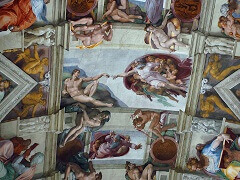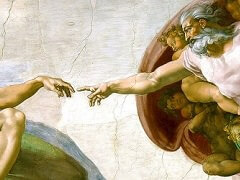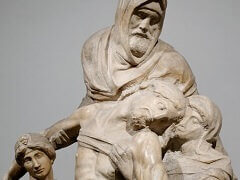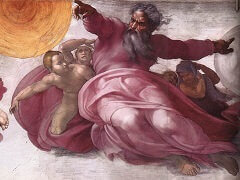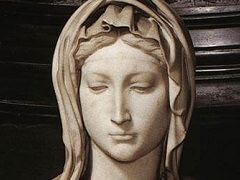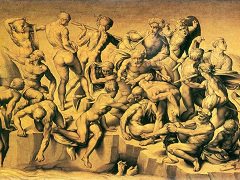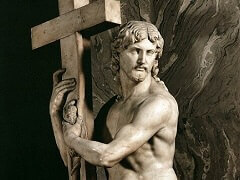Doni Tondo, by Michelangelo

The Doni Tondo, sometimes called The Holy Family, is the only finished panel painting by the mature Michelangelo to survive. Now in the Uffizi in Florence, Italy, and still in its
original frame, the painting was probably commissioned by Agnolo Doni to commemorate his marriage to Maddalena Strozzi, the daughter of a powerful Tuscan family. The painting is in the form of
a tondo, or round frame, which is frequently associated during the Renaissance with domestic ideas.
The work was most likely created during the period after the Doni's marriage in 1503 or 1504, as well as after the excavation of the Laocoon about 1506, yet before Sistine Chapel ceiling frescoes
were begun in 1508, dating the painting to approximately late 1506 or 1507. The Doni Tondo features the Christian Holy family (the child Jesus, Mary, and Saint Joseph) along with John the Baptist
in the foreground and contains five ambiguous nude male figures in the background. The inclusion of these nude figures has been interpreted in a variety of ways.
The Virgin Mary is the most prominent figure in the composition, taking up much of the center of the image. Mary sits directly on the ground without a cushion between herself and the ground, to
better communicate the theme of her relationship to the earth. The grass directly below the figure is green, which sharply contrasts to the grassless ground surrounding her, although the green
is now darker and less visible than it was originally. Saint Joseph has a higher position in the image compared to Mary, perhaps as the head of the family, although this is an unusual feature
in compositions of the Holy Family. Mary is located between his legs, as if he is protecting her. There is some debate as to whether Mary is receiving the Christ child from Joseph or vice-versa.
The painting is still in its original frame, one that Michelangelo might have influenced or helped design. The frame is ornately carved and rather unusual for the five heads it contains which
protrude three-dimensionally into space. Similar to the nudes of the background, the meanings of these heads has been subject to speculation.
The composition is, most likely, partially influenced by The Virgin and Child with St. Anne of
Leonardo da Vinci. Like this earlier cartoon, Michelangelo's figures seem to be compacted into very little pictorial space and a similar bilaterally
symmetrical triangular composition is employed. Michelangelo saw the drawing in 1501 while in Florence working on the David.


